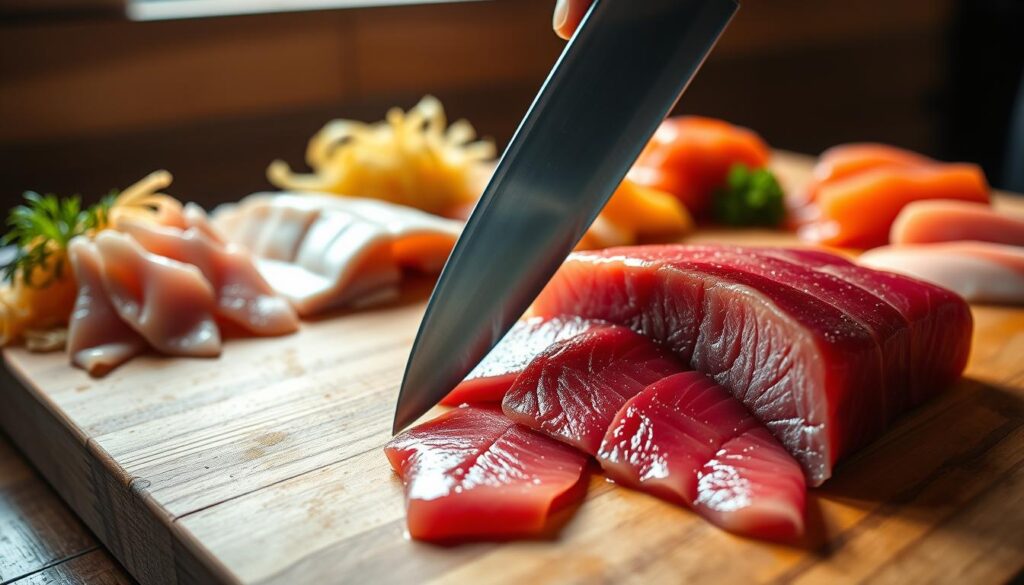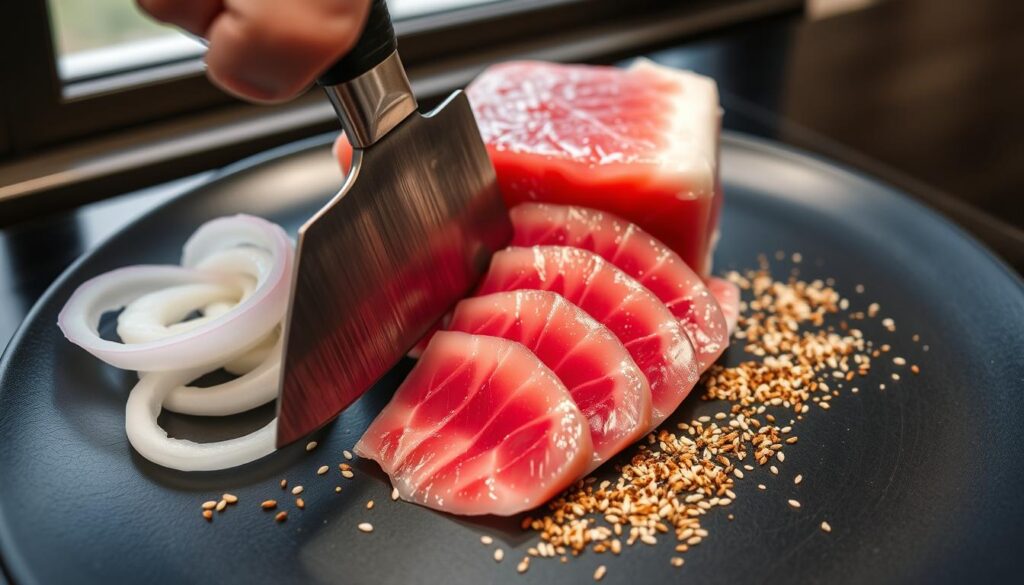How to Make Sashimi at Home: Step-by-Step Guide
The first time I tasted authentic sashimi in a small Tokyo restaurant, I was amazed. The fresh fish slices were so delicate, they melted in my mouth. This experience made me want to learn how to make sashimi at home.
Making homemade sashimi is more than just cutting raw fish. It’s a detailed art that needs skill, knowledge, and respect for the ingredients. This guide will show you how to make sashimi like a pro, from picking the right fish to serving it with finesse.
If you love cooking or sushi, learning to make sashimi will be exciting. You’ll learn how to choose, prepare, and serve this elegant Japanese dish at home.
Table of Contents
Essential Tools and Equipment for Sashimi Preparation
Making perfect sashimi is more than just cooking. It needs special tools for precision, safety, and quality. Knowing the right equipment is key to making sashimi like a pro at home.
Choosing the Right Sashimi Knife
Start with the perfect blade for your sashimi knife techniques. A yanagiba knife is the top choice. It’s long, thin, and has special features:
- Single-beveled blade for ultra-precise cuts
- Typically 8-12 inches long
- Razor-sharp edge for clean fish slicing
- Lightweight design for optimal control
Additional Kitchen Tools Required
There are more tools to help you prepare sashimi:
- High-quality cutting board (preferably wooden)
- Sharp tweezers for bone removal
- Precise fish scaling tool
- Clean kitchen towels
- Refrigerated workspace
Safety and Hygiene Equipment
Keeping things clean is critical when handling raw fish. Get professional-grade safety gear for your safety and food safety:
- Food-grade disposable gloves
- Sanitizing solution for workspace
- Separate cutting surfaces for fish
- Instant-read food thermometer
With the right tools and attention to detail, you can make sashimi like a pro in your kitchen.
Selecting Sushi-Grade Fish for Your Sashimi
Choosing the right fresh fish for sashimi is key to a great raw fish experience. Not all fish is safe for eating raw. So, knowing what sushi-grade fish is important for home cooks.
When picking the best fish for sashimi, look for a few important things:
- Pristine freshness with clear, bright eyes
- Firm, resilient flesh without discoloration
- Clean, ocean-like smell without any fishy odors
- Proper handling and flash-freezing to eliminate parasites
The quality of your sashimi depends on the fish you pick. Sushi-grade fish must meet strict safety standards to be safe to eat raw.
| Fish Type | Sashimi Quality Rating | Recommended Source |
|---|---|---|
| Bluefin Tuna | Excellent | Specialty seafood markets |
| Salmon | Very Good | Japanese grocery stores |
| Yellowtail | Good | Professional fish markets |
To get the best quality, buy your sashimi-grade fish from trusted places. Look for specialized seafood markets, Japanese grocery stores, or online fishmongers who know what raw fish needs.
Understanding Different Types of Fish for Sashimi
Choosing the right fish for sashimi is important. Not all fish are good for eating raw. You need to pick fresh, high-quality fish with the right qualities.
Exploring sashimi, you’ll find many fish with unique tastes and textures. Knowing which fish are best for raw eating is key.
Popular Fish Varieties for Sashimi
- Tuna (Maguro): The top choice for sashimi
- Salmon (Sake): Has a buttery texture and rich taste
- Yellowtail (Hamachi): Offers a delicate and smooth feel
- Mackerel (Saba): Known for its strong, intense flavor
Seasonal Fish Selection Guide
Fish quality changes with the seasons. The taste and texture of fish vary, so picking the best time is important.
| Season | Recommended Fish | Flavor Profile |
|---|---|---|
| Spring | Halibut | Mild, delicate |
| Summer | Mackerel | Rich, oily |
| Autumn | Yellowtail | Smooth, fatty |
| Winter | Bluefin Tuna | Intense, meaty |
Fish Quality Indicators
When picking fish for sashimi, look for these signs:
- Bright, clear eyes
- Firm, elastic flesh
- Fresh, ocean-like smell
- Minimal discoloration
Knowing about these fish and quality signs will help you make better sashimi at home. You’ll enjoy raw fish like a pro.
How to Make Sashimi: Basic Techniques

Learning to make sashimi is all about precision and skill. Your journey starts with mastering the basic techniques. These steps turn fresh fish into a delicate dish. It’s all about patience and paying close attention to every detail.
First, pick the right fish for your sashimi. Fresh, high-quality fish is key for the best taste and texture. Make sure you have clean, sharp knives and a stable cutting surface ready.
- Use a long, sharp yanagiba knife for precise cutting
- Ensure the fish is thoroughly chilled before slicing
- Cut against the grain for optimal tenderness
- Aim for uniform, thin slices approximately 1/8 inch thick
There are different ways to cut sashimi. The traditional diagonal cut, usuzukuri, makes very thin slices. This shows off the fish’s tender texture. To get professional-looking slices, keep your angle and motion smooth and consistent.
Keeping the fish cold is very important. This helps keep its quality and prevents bacteria from growing. Always use a sharp knife and clean it between cuts. This way, each slice will be perfect and delicious.
Proper Fish Handling and Preparation Steps
Sashimi preparation needs careful attention and strict safety rules. Raw fish must be handled with care for a safe and tasty meal. Knowing how to clean, store, and prepare fish is key to making great sashimi at home.
Professional chefs start with great fish handling for sashimi. How you manage raw fish affects the quality and safety of your dish.
Cleaning and Scaling Methods
Here are the essential cleaning steps for fish:
- Rinse fish under cold running water
- Remove scales carefully using a scaling tool
- Pat fish dry with clean paper towels
- Inspect fish for any remaining bones or imperfections
Temperature Control Guidelines
Keeping the right temperatures is key in sashimi prep. Here’s a quick guide for fish management:
| Stage | Recommended Temperature | Duration |
|---|---|---|
| Storage | Below 40°F (4°C) | Maximum 2 days |
| Preparation | 35-38°F (2-3°C) | Minimal time |
| Serving | Below 40°F (4°C) | Less than 2 hours |
Safe Fish Storage Practices
Keep your sashimi fresh with these storage tips:
- Use airtight containers
- Store fish on a bed of crushed ice
- Keep fish in the coldest part of the refrigerator
- Consume within 24 hours of purchase
By following these guidelines, you can make sashimi dishes safely and with confidence.
Essential Cutting Techniques and Presentation

Learning sashimi knife techniques is key to making top-notch fish dishes at home. Your sashimi cutting guide starts with the basic slicing methods. These methods turn raw fish into a beautiful dish.
Professional chefs use three main sashimi cutting styles. These styles greatly affect the texture and look of the dish:
- Hira-zukuri: Rectangular slices, often used for tuna and salmon
- Usu-zukuri: Ultra-thin cuts, perfect for delicate fish
- Kaku-zukuri: Precise square-shaped pieces for a nice look
Your sashimi knife techniques should keep a steady angle. Use smooth, one-way strokes. This helps make uniform slices that highlight the fish’s natural texture and color.
Presentation makes good sashimi even better. Try arranging your cuts in fancy patterns:
- Fan-shaped displays
- Flower-like configurations
- Geometric overlapping designs
Sharp, high-quality knives are vital for professional sashimi cuts. Get a traditional Japanese sashimi knife. It has a long, thin blade for precise slicing.
Traditional Sashimi Accompaniments and Garnishes
Making authentic japanese sashimi at home is more than picking the right fish. The right sides can make your sashimi dish stand out. Learning about traditional garnishes and condiments will help you create a real Japanese dining experience.
Classic Condiments and Sauces
When making japanese sashimi at home, you need a few key condiments:
- Soy Sauce (Shoyu): A must for dipping
- Wasabi: Adds a sharp, spicy flavor
- Pickled Ginger (Gari): Cleanses your palate between fish
Decorative Elements and Plating
How you present your sashimi is key. Here are some tips:
- Use shredded daikon radish as a base for your fish
- Arrange slices in a fan pattern
- Top with microgreens or edible flowers
Complementary Side Dishes
| Side Dish | Flavor Profile | Pairing Recommendation |
|---|---|---|
| Miso Soup | Umami, warm | Light, white-fleshed fish |
| Seaweed Salad | Fresh, briny | Fatty tuna or salmon |
| Cucumber Sunomono | Tangy, refreshing | Delicate fish varieties |
Mastering these sides will make your japanese sashimi at home look and taste like a restaurant dish. It will impress your guests and satisfy your taste buds.
Safe Storage and Serving Guidelines
Making homemade sashimi needs careful storage and serving tips. This ensures your fish stays safe and tasty. Knowing food safety basics is key to keeping your sashimi fresh.
Here’s how to store your homemade sashimi right:
- Refrigerate it right after you make it
- Use airtight containers to stop contamination
- Keep it cold, below 40°F (4°C)
- Eat it within 24 hours of making it
Keeping the right temperature is very important. Bacteria grow fast between 40°F and 140°F. Your fridge should stay cold to keep the fish good and stop bacteria.
Here’s how to serve your homemade sashimi:
- Take it out of the fridge just before you serve it
- Use clean, cold plates
- Serve small amounts to keep it at the right temperature
- Throw away any sashimi that’s been at room temperature for over 2 hours
Pro tip: Always trust your senses. If the sashimi smells bad or looks off, throw it away right away.
By sticking to these storage and serving tips, you’ll have a safe and tasty homemade sashimi. It will keep the flavors and textures of your dish just right.
Conclusion
Learning to make sashimi at home is a journey that mixes skill, precision, and passion. You’ll learn about choosing the right fish, preparing it, and how to present it. This knowledge turns your kitchen into a place where you can enjoy sushi like a pro.
Remember, becoming good at making sashimi takes time and practice. Start with the best fish and use the right tools. Always keep food safety in mind. Every slice you make shows your skill and respect for Japanese cooking.
Your skills will grow as you keep practicing. Try different fish, add unique garnishes, and work on your cutting. Making sashimi at home lets you make it your own while keeping it true to tradition.
Creating sashimi is not just cooking; it’s an art that connects you to a deep food tradition. Enjoy the learning, stay curious, and relish the tasty results of your hard work in mastering this Japanese delicacy.
FAQ
What is sashimi-grade fish, and why is it important?
What are the best types of fish for making sashimi at home?
How can I ensure the fish is safe to eat raw?
What special knife do I need to make sashimi?
How do I cut fish for sashimi?
How long can I keep prepared sashimi in the refrigerator?
What are traditional sashimi accompaniments?
Can I make sashimi from any type of fish I find at the grocery store?
How do I know if the fish is fresh enough for sashimi?
Is it safe to make sashimi at home?
There are no reviews yet. Be the first one to write one.

